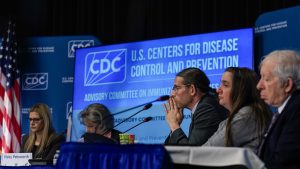The demise of pharmacies: How ‘bloated’ chains limit health care access

Closures of American pharmacies have surged over the last decade and a half, taking a toll on the nation’s health care system. Consolidation within the industry has weighed on large retail chains as big players have amassed thousands of locations throughout the country.
This is part one of a three-part series on struggles within American pharmacies and the impact those struggles have on access to health care.
Roughly 30% of U.S. pharmacies closed from 2010-2020, according to researchers from the University of Southern California and UC Berkeley. A report published at the end of 2024 found closures had accelerated at the end of the decade, contributing to a net loss in the total number of pharmacies.
Health care
Roughly 1 in 3 U.S. retail pharmacies have closed since 2010.

‘Bloated’ national pharmacy chains
“The problem that these pharmacy chains have is that they’re bloated,” supply chain and business strategy consultant Brittain Ladd told Straight Arrow News. “They have too many stores, they have too many residual businesses, health care businesses and so forth.”
National retail chains have grown over the decades. Acquisitions were an early part of Walgreens’ strategy. It started its growth campaign by buying a malted milkshake company owned by an employee in 1922. More recently, it completed a two-step merger with Alliance Boots, the largest pharmaceutical wholesaler in Europe.
This year, private equity firm Sycamore agreed to buy the company for $10 billion with plans to take it private. Walgreens attempted to acquire Rite Aid, but regulators stopped the acquisition.
Rite Aid itself amassed enough regional pharmacies to reach 4,000 locations by 1996. It continued its purchase campaign by buying 1,854 Brooks and Eckerd stores in 2007. Rite Aid also bought Seattle-based Bartel Drugs in 2020. The company then filed for bankruptcy in 2023.
In 1997, CVS started growing after it added 2,500 Revco Discount Drug Stores. In 2015, it took over Target’s pharmacy and health business at 1,600 locations. CVS’ growth strategy eventually involved buying an insurance provider and pharmacy benefit manager.
“These pharmacies are still treating everybody as customers, and they’re not taking the success of the customers personally, and that’s what’s killing them,” Ladd added.
“Despite the size these companies are now, and the incredible amounts of money that is flowing through them, they’re not making enough money to satisfy Wall Street,” former health insurance executive Wendell Potter told Straight Arrow News. “Because of that, these companies have to do even more to meet the expectations of those investors. And that means they’re going to be looking at those stores to close there, and they’re going to be looking at accounts to get rid of.”
Retail struggles
Most U.S. drug stores are split into two sections. The pharmacy dispenses prescription drugs, while the front end handles the retail operations of convenience items and over-the-counter medicines.
“They’ve just simply not been able to crack the code when it was related to retail,” Ladd said of brick-and-mortar chain pharmacy struggles. “A lot of pharmacy companies just are not very good at retail at all.”
Industry advocates warn that if stores continue to close, it will have a major impact on the accessibility of health care.
“Pharmacists are the most accessible health care professionals in America,” Rep. Buddy Carter, R-Ga., who is a pharmacist by trade, told Straight Arrow News. “But if we keep closing these pharmacies, particularly in the rural areas, that accessibility to health care is going to suffer.”
Consolidation in the industry goes well beyond increasing the number of stores. In the second part of this series, Straight Arrow News digs into how consolidation within insurance providers has given rise to pharmacy benefit managers.





